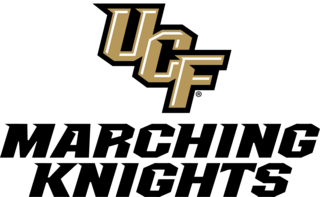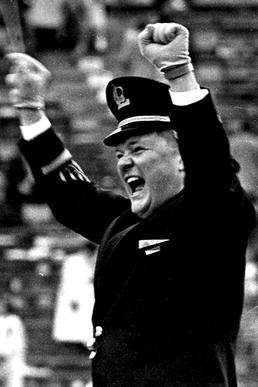
The Pride of the Southland Band is the marching band of the University of Tennessee in Knoxville, TN. The band performs at all Tennessee home football games and select away games each year. The Pride of the Southland is recognized as one of the nation's top collegiate marching bands. The Pride of the Southland is popular for the well-renowned traditions of the band, as well as the simplicity of the band itself. The band is known for their "Big Orange Sound" across the country.

The Frost Band of the Hour, sometimes abbreviated as simply Band of the Hour, is the marching band at the University of Miami in Coral Gables, Florida.

The Spartan Marching Band (SMB) is the marching band of Michigan State University. The band has over 300 members and was founded in 1870. Notable music educator Leonard Falcone directed the band from 1927 through 1967.

The Marching Knights are the official marching band of The University of Central Florida in Orlando, Florida, USA. The Marching Knights are the largest and the most visible student organization at the University of Central Florida. They are known for their high-energy performances and unique drill designs. Their musical selections are also notable for including a variety of genres.

The Michigan Marching Band is the official marching band of the University of Michigan. The band performs at all Michigan Wolverines football home games, select away games, and numerous concerts, pep rallies, and parades. As a student musical ensemble, the MMB evolved from the original Michigan Band of twenty-two players in 1896 to today's band of over 400 members.

The Northwestern Wildcats football team represents Northwestern University as an NCAA Division I college football team and member of the Big Ten Conference based near Chicago in Evanston, Illinois. Founded in 1851, Northwestern began playing football in 1882. Its football mascot is the Wildcat, a term coined by a Chicago Tribune reporter in 1924, after reporting on a football game where the players appeared as "a wall of purple wildcats". Northwestern Football is also marketed as "Chicago's Big Ten Team" with its proximity and ties to Chicago.

Formed in 1845, the Holy Cross Goodtime Marching Band is one of the oldest organizations at The College of the Holy Cross in Worcester, Massachusetts, USA, and one of the oldest college bands in the United States. The Crusaders Marching Band first began performing at football games in 1910 and the band's role has expanded significantly since to include other athletic appearances, performing at all home football games, selected away games, in exhibition at high school band competitions, and at various events throughout the country. In the spring, the marching band converts into the Holy Cross Crusader Pep Band and plays at all home basketball games, and travels with the teams to the NCAA tournament. The Marching Band performs at Fitton Field while the Pep Band plays in the Hart Center.

The Hawkeye Marching Band is the marching band for the University of Iowa. The band performs at all home Hawkeye football games at Kinnick Stadium in addition to other events. It is the largest and most visible musical ensemble at the university. The band was founded in 1881 as a military band, giving membership to both music students and members of the military. In 1990, the band was awarded the Louis Sudler Intercollegiate Marching Band Trophy, generally considered to be the most prestigious honor a collegiate marching band can receive.

The University of Minnesota Marching Band is the marching band of the University of Minnesota and the flagship university band for the state of Minnesota. The Pride of Minnesota serves as an ambassador for the university, representing the school at major events both on and off campus. The band performs before, during, and after all home Golden Gopher football games and bowl games, occasional away games, local parades, numerous pepfests, exhibition performances, as well as a series of indoor concerts toward the end of the regular football season. Members of the band, along with non-member students, also participate in smaller athletic pep bands that perform at other major sporting events, including men's hockey, men's basketball, women's hockey, women's basketball, and women's volleyball.

The University of Wisconsin Marching Band is the marching band for the University of Wisconsin–Madison. It was formed in the fall of 1885 to support the university military battalion. Today, it has grown to about 300 members and performs at all home Badger football games. They are known for their intense and athletic high knee “stop at the top” marching style.

The Kansas State University Marching Band, also known as "The Pride of Wildcat Land" or just The Pride, is a 400+ piece marching band consisting of woodwinds, brass, percussion, color guard, dancers, and twirlers. It is the official band of Kansas State University.

The Herd of Thunder is the name for the athletic bands of the University of South Florida, which includes the show band, "Rumble" pep band, and marching band ensembles, although it is often used to refer simply to the Marching Band. The Herd of Thunder was founded in 1999, two years after USF fielded its first football team.

Oregon State University Marching Band, ("OSUMB"), is the marching band of Oregon State University, known as the "Spirit and Sound of OSU." The band was established in 1891. It is one of the oldest bands in the Pac-12 and the primary athletic band at Oregon State. In addition to the Oregon State University Marching Band, other athletic bands include Basketball Band, Rhythm & Beavs, Rhythm & Beavs: Travel Band, the Away Game Pep Band, Alumni Band, Gymnastics Band, and Bar Band. All band members are required to participate in marching band before they may be eligible to participate in any of the other athletic bands Oregon State offers.

The Marching Jayhawks, is a 380-piece marching band consisting of woodwinds, brass, percussion, and color guard, representing the University of Kansas in Lawrence, Kansas. The band performs at all home football games and occasionally travels to away games. They also send smaller ensembles to pep rallies around the Kansas City area. The band marches in parades on campus and in downtown Lawrence. The volleyball and basketball pep bands play at all home games and will often travel for post-season play.

The Thunder of the East is the marching band of the University at Buffalo in the State University of New York system. UB's first marching band was created in 1920, and disbanded in 1927. It was revived in 1946, increasing in size and reputation until about 1970. It was known as "The Pride of the East." At that time, it was dissolved upon UB's departure from Division I athletics. In 1981, some UB students continued the tradition of playing music at UB's home football and basketball games by forming UB's Pep Band. In anticipation of UB's return to Division I athletics, a marching band was formed in 1999 and named, "Thunder of the East." The band debuted at the University at Buffalo Stadium on September 11, 1999. The Thunder of the East is currently led by James E. Mauck; and performs at UB's Buffalo Bulls home football games, as well as in other musical venues.

Thomas Tyra was an American composer, arranger, bandmaster, and music educator.

The Wildcat Marching Band (WMB) is the marching band of the University of Kentucky, located in Lexington, Kentucky. The WMB performs at all UK home football games and selected away games. The WMB's repertoire ranges from contemporary jazz to classical favorites. Any UK, BCTC, or Transylvania University student, regardless of major, is eligible for membership. The Wildcat Marching Band is directed by Dr. Shayna Stahl.

Southern Pride is the name for the marching band of Georgia Southern University located in Statesboro, Georgia.
The Bearkat Marching Band, also known as The Famous Bearkat Band or the BMB, is the marching band at Sam Houston State University. The band was founded in 1910 under the direction of C.W. Feuge, and is currently directed by Brian Gibbs. The band appears at Sam Houston football and basketball home games, as well as at pep rallies, the annual Battle of the Piney Woods in Houston, and occasionally at in-state away games.

The Clemson University Tiger Band serves as the Marching Band, Color Guard, Tiger Dancers and Tiger Twirlers of Clemson University. The marching band component of the band is made up of wind instruments, percussion, and auxiliary units, including the piccolo, clarinet, alto saxophone, tenor saxophone, trumpet, horn, trombone, baritone, and sousaphone. To the thousands of fans, it is known as the Tiger Band, or better yet the "band that shakes the Southland". Composed of over 300 members, Tiger Band's mission is to provide inspiring spirit and entertainment to not only the university, but beyond.






















